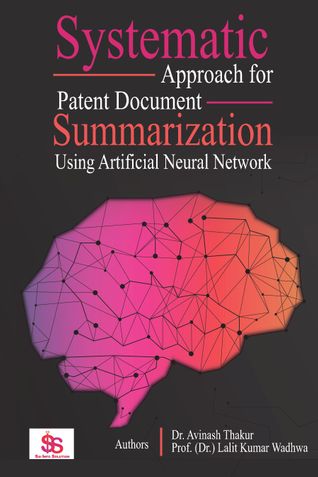Description
In the realm of patent document summarization,
employing artificial neural networks offers a powerful
tool, but its effectiveness relies heavily on a systematic
approach. At the outset, it is paramount to delineate the objectives
clearly. Understanding the nuanced structure of patent documents,
encompassing sections like claims, abstracts, and descriptions, is
fundamental. This foundational comprehension informs subsequent
stages.
The crux of the systematic approach lies in the neural network’s
design. Implementing an encoder-decoder architecture, often with
LSTM or GRU units, facilitates sequence-to-sequence learning.
Incorporating an attention mechanism enables the model to focus
on specific segments of the input text, enriching the quality of the
generated summary. Crucially, user preferences must be integrated
into the learning process. Defining these preferences within the loss
function is key, potentially through reinforcement learning paradigms,
where the model is incentivized based on adherence to these defined
criteria.
The training phase involves the crafting of a custom loss
function that amalgamates traditional sequence-to-sequence loss with
preference-based metrics. Fine-tuning various hyper parameters such
as architecture specifics, learning rates, and batch sizes optimizes the
model’s performance. Post-training, rigorous evaluation using metrics
like ROUGE assists in assessing the quality of generated summaries
against human-authored ones. User feedback serves as a real-world
litmus test, offering invaluable insights into the alignment of summaries
with user preferences. This iterative feedback loop guides refinements, ensuring the system’s continuous enhancement.
Upon achieving satisfactory results, the model can be deployed
in a suitable environment. Continuous monitoring is pivotal, ensuring
that the summarization process consistently aligns with predefined
objectives and user preferences. Establishing a feedback loop,
integrating user insights and system performance metrics, fosters
perpetual improvement. This systematic and iterative approach not only
refines the summarization system but also elevates user satisfaction by
delivering summaries tailored to their specific needs and preferences.
Dr. Avinash Thakur
Executive Director
Dr. D. Y. Patil Institute of Technology, Pimpri Pune-Maharashtra
Dr. Avinash Thakur is currently leading a group of institutions, Dr.
D.Y Patil Unitech society, as an Executive Director for the verticals
Planning, Development, Expansion, Incubation, Linkages and Govt.
Relations.
Earlier to this, Dr. Avinash Thakur has worked with a NITI
Aayog’s flagship initiative Atal Innovation Mission (AIM) - A Govt.
of India’s initiative to promote innovation and entrepreneurship across
the length and breadth of the country. Avinash has worked as CEO
of Atal Incubation Center Pinnacle Industries, Pune with more than
60+ startups which have a valuation of approximately 200+Cr., 90+
mentors, and facilitated total funding of 10+Cr. & created a large impact on Startups & the incubation ecosystems.
Avinash has experience working with different government
ministries like the Ministry of MSME, Ministry of Electronics & IT,
Ministry of Health & Family Welfare etc. & respective ministers,
different government departments & bureaucrats. Recently he received
the “Recipient Fits Asia Award” for excellence in the government
leadership category.
Avinash is startup Coach, Patent Coach & Trainer. He is supporting
establishment of IPR vision and patenting strategy for various research
Labs/industries/SMEs/MSMEs in India. He is guiding, supporting,
and mentoring the overall startups ecosystem in many aspects. He is
also appointed as a “Mentor of change” at AIM, NITI Aayog, GoI.
Currently he is coaching a team of 50+professionals towards planning,
directing, budgeting, supporting, and training people in India. He is
also working closely with the Govt. organizations like CDAC & many
other corporate. He had been invited as a keynote speaker at various
universities and industries in India, USA, and Dubai.
Prof. (Dr.) Lalit Kumar Wadhwa
Principal, Dr. D. Y. Patil Institute of Technology, Pimpri Pune-Maharashtra
Dr. Lalit Kumar Wadhwa is a passionate Teacher and Researcher.
He began his teaching career in Dr. D.Y. Patil Institute of Technology,
Pimpri, Pune (formerly Padmashree Dr. D. Y. Patil College of Engineering
for Women) in 2000. He completed his graduation in Electronics and
Telecommunication Engineering in 1997 and completed Masters in
Electronics Engineering from Government college of Engineering
(COEP), Pune in the year 2000. He completed his Ph.D. from IIT,
Dhanbad in 2016. He has total 24 years of experience in Academics
and Research. He has started his professional career with DIT and
held various positions such as Lecturer, Assistant Professor, Associate Professor, Professor, Dean(FE). His expertise was acknowledged for
developing & designing academic policies for organizations. Dr. Lalit
Kumar Wadhwa is responsible and instrumental in implementation of
best innovative Teaching-Learning practices and to get Institutional
accreditation from NAAC & NBA. He believes in faithful quality
knowledge transformation. Apart from his vast teaching experience, he
is very good administrator and he has been firmly result-oriented with
his vision aligned with the institutional vision. One such success story
is of University Toppers under his leadership & guidance.
He has published more than 20 research papers in National and
International Journals. He has also authored 4 books and filed 4 patents
and 1 copyright to his credits. He won the award in E-Yantra Robotics
competition at IIT, Bombay. He is the member of professional bodies
such as ISTE, IEEE and elected Executive member of IETE at Pune
center. He is also contributing to Industry through giving lectures,
seminars and projects.
Dr. Lalit Kumar Wadhwa is a student centric Principal and always
striving for students’ welfare and their academic and professional
development.
ISBN: 9788197080364
Publisher: Sai Info Solution Press & Publication
Number of Pages: 73
Dimensions: 6.00"x9.00"
Interior Pages: Full Color
Binding:
Paperback (Perfect Binding)
Availability:
In Stock (Print on Demand)


 Free Shipping
Free Shipping



